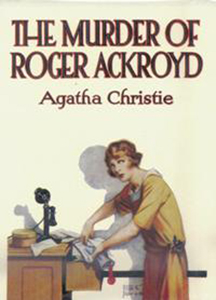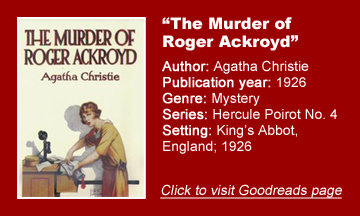“The Murder of Roger Ackroyd” (1926) often appears on top 10 lists of Agatha Christie novels (it was even named the best crime novel of all time by a 2013 panel), and that’s well deserved. It’s armed with one of the most famous endings in mystery-novel history, and Hercule Poirot is in vintage form even though this is only his third novel.
At first blush, it’s strange that Poirot acquires a new amateur assistant – King’s Abbot town doctor James Sheppard, who also serves as the narrator – and I wondered if we’re not missing out on something by not having Hastings or someone else be the regular Watson to Poirot’s Holmes.
Nothing for granted
But I eventually developed a different view. While Christie and readers do have a lot of fun with characters not knowing Poirot’s proclivities the way we do, “Ackroyd” takes advantage of the fact that we can’t take anything else for granted.
As with “The Secret of Chimneys,” this novel features a household full of suspects at a country manor. Aside from everyone’s reactions to Poirot, it’s not as delightfully funny as the nearly romp-like “Chimneys,” preferring to emphasize detailed and grounded plotting.
Well, I must admit I got some smiles out of Sheppard’s sister Caroline, who is to 1926 what a social-media gossiper and theorizer is to today – the person who sits at a keyboard and solves all the issues of the day.
To the doc’s amusement (he’s accustomed to her, after all), Caroline has knowledge of everything without leaving the house all that often.
Even in medical cases, she claims insight that she says her brother doesn’t have because, although he may have medical training, he lacks her imagination. (Caroline isn’t a total out-of-touch joke, though; she often makes good observations. Sheppard has learned how to separate the wheat from the chaff in her commentaries.)
House of suspects
The Ackroyd household – home of most of the suspects – serves up a mystery to go with nearly every member, including Roger’s lovely marriage-eligible niece Flora; Flora’s panicky mother; Roger’s big-game hunter friend; and several staffers who don’t trust one another.
We get romance and financial intrigue, and plenty of clues (for some reason called “clews” in the version I read, as if everyone has a Rory Gilmore-style inflection). Hanging like a shadow over everything is the disappearance of a central suspect, Roger’s adopted son.
I’m one of those mystery readers who generally appreciates the journey more than the ending. Sometimes I can re-read a book where I forgot the ending’s specifics even though I remember loving the book.
However, “Ackroyd’s” ending is unforgettable. Yet it also plays in such a way that you want to re-read the novel because of the new perspective that’s illuminated at the end.
The final act (Spoilers)
“Ackroyd” was published 95 years ago, but on the off chance that someone is reading this review without having read the book, you should not read beyond this SPOILER WARNING.

Part and parcel with enjoying the journey, I’m not the type of reader who deliberately tries to figure out whodunit. I don’t set down the book and mull over suspects, maybe because Poirot (with help from Sheppard here) does that himself, and I know my little gray cells can’t compete with his.
That said, possibilities did percolate in the back of my mind, and partway through “Ackroyd,” I thought: “Wouldn’t it be something if the narrator is the murderer?”
I had managed to go my whole life without learning the famous twist of this book, but maybe it’s in the public consciousness and so it seeped into my brain. Or maybe it’s Christie’s subtle skill; I had a sense that the doctor wasn’t telling me everything, even though he didn’t seem to be skipping over anything relevant to the case.
Even if you correctly guess that the narrator is the killer, it’s a blast to read the chapter where Poirot – alone with the doctor after his usual inquiry featuring all the players – spells out the solution to Sheppard.
Christie adds on to this neat trick with the notion that Sheppard is chronicling this case on paper from his own POV, so the book we’re reading doubles as Sheppard’s chronicle.
In the “Apologia” chapter, the killer points out to the reader the moments when he held back damning information – even though, strictly speaking, he never lies to us.
While I didn’t immediately re-read the whole book, I did page back to key segments, assuring to myself that — yes indeed – Christie did play fair.
Every week, Sleuthing Sunday reviews an Agatha Christie book or adaptation. Click here to visit our Agatha Christie Zone.


